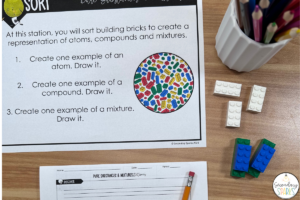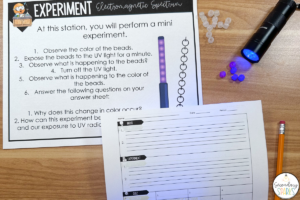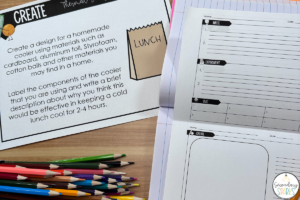There are lots of new, shiny classroom strategies out there, but sometimes the tried-and-true activities are just the best. That’s why I’ll always be a big fan of middle school science stations. Classroom time is limited and precious, but stations allow you to expand how much you can touch on, differentiate for students, and challenge students’ knowledge in new ways. Let’s talk about some reasons to use classroom stations in physical science.
#1 Middle School Science Stations increase engagement.
Stations provide a hands-on and interactive approach to learning with opportunities for mini-experiments, science demonstrations, observations, and more. Stations also bring movement into your classroom as students hop from table to table completing assignments. For those students who struggle to sit still, this is a must.

#2 Classroom stations are built for differentiation.
Stations in the classroom are a natural way to cater to different learning styles. Set up one station to allow for experimentation, another to allow for creativity, and another to encourage collaboration while vocabulary sorting. This means there is something for every student that will play to their strengths while also challenging their skills.
#3 Stations ensure active learning.
When participating in stations, students aren’t just “sitting and getting.” Instead, they’re actively involved in the learning process. Classroom stations can include activities that promote higher-order thinking, opportunities to flex problem-solving muscles, and a chance to think critically.

#4 Classroom stations help students make real-world connections.
Stations are great for applying what students are learning to the real world. Students are often searching for a purpose in learning (which is why they bug you with those “why do I need to know this?” questions). Classroom stations give them a chance to make connections and apply what they are learning to real-world scenarios.
#5 Stations in the classroom are time efficient.
With stations, you can cover a variety of topics and activities in a single class period. That means you could review several units, concepts, or subjects within a short period of time. As I said, time in the classroom is precious, but you can maximize it with stations.
#6 Classroom stations make great assessment opportunities.

Because students are working on various skills or challenging their knowledge in new ways, stations can make great informal assessments. You can see where students are excelling and where they need more support. You can even craft specialized stations for struggling students to provide support.
If the thought of using stations in the classroom has you excited, but you aren’t thrilled about the amount of time it will take you to create them, check out my Physical Science Stations Bundle!
This bundle has seven types of differentiated stations that require very little prep. Classroom stations will keep your students engaged and actively learning, will meet their needs through differentiation, and will help them make real-world connections. Plus, you’ll be able to easily assess their knowledge, all while being as efficient as possible!

[…] a little bit of research and a mini lab all in one class period. That’s the beauty of using stations in middle school science. You can do so many activities and informally assess students in a variety of ways, all in the span […]